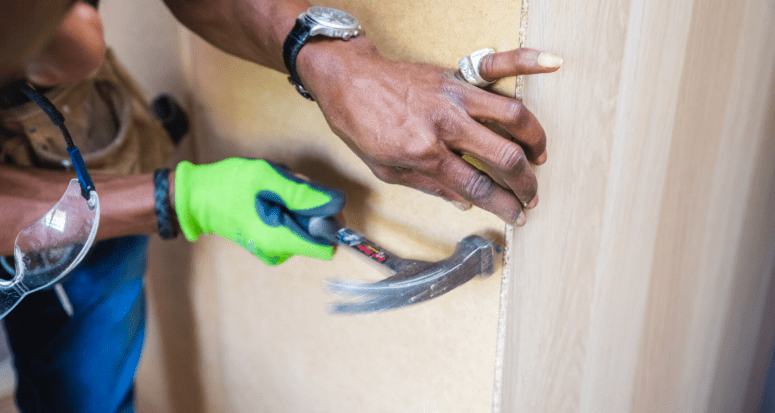Budgeting for Home Maintenance: How Much Should You Set Aside?
- Published on
- 5 min read
-
 Melissa Rudy Contributing AuthorClose
Melissa Rudy Contributing AuthorClose Melissa Rudy Contributing Author
Melissa Rudy Contributing AuthorMelissa Rudy is a seasoned digital journalist with 15 years of experience writing web copy, blog posts and articles for a broad range of companies. When she can’t buy or sell homes, she settles for the next-best thing: researching and writing about all things real estate-related.
All homes need maintenance to some degree. Home Advisor’s State of Home Spending Report found that in 2018, homeowners spent an average of $1,105 on maintenance and $416 on emergency home expenses. But this can vary based on the age of your home as well as the materials and workmanship that went into building it. How much should you personally set aside to cover day-to-day expenses and ward off any big-ticket surprises?

How much to budget for home maintenance
One popular rule is to set aside 1%-3% of the home’s value for a home-maintenance fund, but Connie Taylor, a top agent in Amarillo, Texas, recommends using the “square footage rule,” which says to budget $1 per square foot, per year. “The value of a home can change, but the square footage won’t,” she points out.
This means that for a 2,600-square-foot home, your annual home maintenance budget would be $2,600.
Aside from the home maintenance budget, Taylor says it’s wise to also have cash reserves for any bigger, one-time costs, such as replacing an HVAC system, water heater, or kitchen appliance. For this fund, she recommends starting with $1,000 and working up from there.
The key is to be proactive and create a home maintenance budget from day one, rather than only reacting when things go wrong. By setting aside smaller, more manageable amounts of money on a regular basis, you’ll be less likely to have to sink a large chunk of cash into expensive overhauls down the road.
As an example, let’s say you’re planning to replace your aging roof eventually and before it starts causing problems. According to Remodeling Magazine’s Cost versus Value Index, in 2019, an asphalt roof replacement averaged about $22,000.
“That is probably a very scary number for many homeowners, but if you have the money set aside for a new roof, then you can use your maintenance budget for smaller repairs, like fixing a garage door or replacing a faucet,” Taylor points out.
And in the best-case scenario, you can tap into any available warranties to cover major repairs or replacements. Check out this guide that estimates home-repair costs with and without warranties.
Also, it’s a good idea to include the amount of your homeowners’ insurance deductible in your reserve account, so you’ll be prepared to make a claim for any covered repairs, such as hail damage to a roof. Check with your insurance company to see whether your deductible is a fixed-dollar amount or based on a percentage of the repair costs.
How to tailor your budget to what your home needs
In addition to square footage and/or home value, there are other factors to consider when planning your home maintenance budget:
- Age of the home:
This will directly correlate to the age of any major systems and components, like the HVAC system, plumbing, kitchen appliances, and roof. You should plan to replace your major appliances about every 10-15 years and keep in mind that even a brand-new home will require some level of maintenance. - Plans for future renovations:
If you know that you want to update a bathroom in a few years, for example, you can break down that cost into a monthly amount and add that to your maintenance budget. - The regional climate:
Seaside homes can take a beating from corrosive salt air and storms, so there might be a greater need for maintenance to paint, fences, and roofing. And if you live in an area that sees harsh winters, you’ll want to build in snow removal costs. - Materials:
Some materials will require more or less maintenance than others. For example, Hardie board (cement board) siding tends to offer greater longevity and durability, while stucco can be more prone to damage. - Number of levels:
Homes with basements will be more vulnerable to water damage and flooding, for example. - Family size and activity level:
Generally speaking, the more children in a household, the greater the chance of wear and tear and the more frequent need for paint touch-ups and repairs.

Where should you keep your home maintenance savings?
A standard savings account will work, but you may want to consider options that offer a better return rate so your savings are making you money while they sit. Certificates of deposit (CDs) or IRAs aren’t great for this purpose because they may be hard to pull money from or charge a penalty fee for early access.
Better options include a high-yield savings account or a money market account where you’ll still get a solid return rate, and you can easily withdraw the funds as needed.
What will your home maintenance budget go toward?
Generally speaking, home maintenance is performed in order to keep your property in the condition it is currently in, while renovations or upgrades are done when you want to change or improve something.
A home maintenance budget should focus primarily on routine upkeep, repairs/fixes, and prevention of bigger problems, rather than larger projects like gutting and replacing a bathroom or kitchen. Of course, there might be times when there’s some overlap. For instance, if you’re faced with replacing a leaky faucet, it might make sense to upgrade to a nicer fixture.

Common home maintenance items
Drilling down into the specifics, what types of things would fall into the home maintenance category? Taylor offers some examples of preventative items and common fixes:
Interior:
- Have the HVAC system routinely serviced (following an HVAC maintenance checklist can help keep your system running smoothly).
- Replace air filters as recommended by the manufacturer (check out this handy timing guide).
- Vacuum air vents to remove dust as needed.
- Run hot and cold water in bathrooms that are not often used to prevent sewer gas from leaking into the home.
- Repair any grout cracks in wet areas with silicone caulk.
- Clean garbage disposals (Taylor recommends using ice cubes as a thrifty solution).
- Turn valves under sinks at least once a year to prevent them from getting stuck.
- Service kitchen appliances as needed to keep them in good working order (Mr. Appliance offers some preventative maintenance tips).
- Repair squeaky door hinges (try this tip to silence them without the use of any toxic chemicals).
- Clean out/lubricate window tracks.
- Clean out faucet aerators to remove hard-water deposits.
- Test all smoke alarms and replace batteries as needed.
- Check fire extinguishers once a year to make sure they haven’t expired.
- Take care of any pest or termite control needs.
Outside:
- Seal and/or stain the deck as needed.
- Clean out yard drains to remove excess leaves and prevent clogs (here’s how).
- Trim trees and bushes.
- Touch up any peeling or faded paint (a fresh coat of exterior paint has been shown to increase the home’s value).
- Freshen up mulch and plants seasonally.
Plan for home maintenance now, and you’ll be grateful when you sell
By having a home maintenance budget, you’ll be better able to keep up with day-to-day upkeep. That means when it comes time to put your home on the market, you’ll already be ahead of the game.
Instead of rushing to take care of a long list of repairs and deferred maintenance, you’ll have more time to focus on decluttering, packing, staging, and enhancing curb appeal to help sell your home faster. Proper maintenance will also preserve your home’s value long term so you can command a price you’re happy with when the time comes to sell.
Header Image Source: (Bidvine / Pexels)
